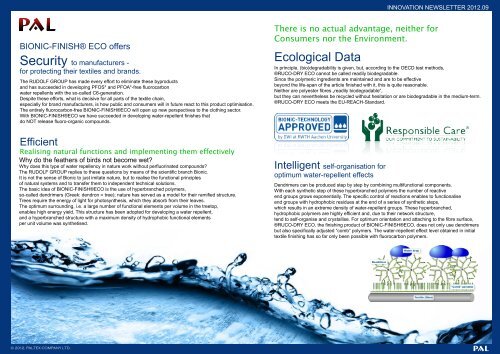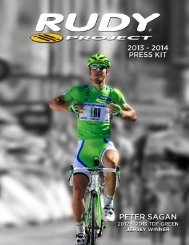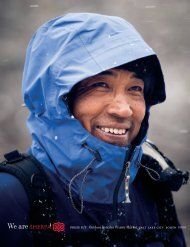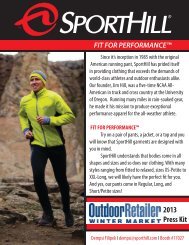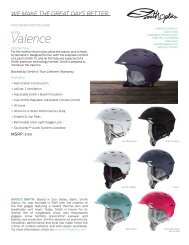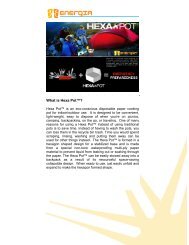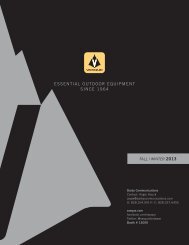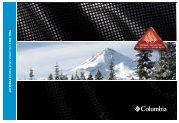paltex-eco issue-2013
paltex-eco issue-2013
paltex-eco issue-2013
You also want an ePaper? Increase the reach of your titles
YUMPU automatically turns print PDFs into web optimized ePapers that Google loves.
INNOVATION NEWSLETTER 2012.09<br />
BIONIC-FINISH® ECO offers<br />
Security to manufacturers -<br />
for protecting their textiles and brands.<br />
The RUDOLF GROUP has made every effort to eliminate these byproducts<br />
and has succeeded in developing PFOS* and PFOA*-free fluorocarbon<br />
water repellents with the so-called C6-generation.<br />
Despite these efforts, what is decisive for all parts of the textile chain,<br />
especially for brand manufacturers, is how public and consumers will in future react to this product optimisation.<br />
The entirely fluorocarbon-free BIONIC-FINISH®ECO will open up new perspectives to the clothing sector.<br />
With BIONIC-FINISH®ECO we have succeeded in developing water-repellent finishes that<br />
do NOT release fluoro-organic compounds.<br />
Efficient<br />
Realising natural functions and implementing them effectively<br />
Why do the feathers of birds not b<strong>eco</strong>me wet<br />
Why does this type of water repellency in nature work without perfluorinated compounds<br />
The RUDOLF GROUP replies to these questions by means of the scientific branch Bionic.<br />
It is not the sense of Bionic to just imitate nature, but to realise the functional principles<br />
of natural systems and to transfer them to independent technical solutions.<br />
The basic idea of BIONIC-FINISH®ECO is the use of hyperbranched polymers,<br />
so-called dendrimers (Greek: dendron = tree); nature has served as a model for their ramified structure.<br />
Trees require the energy of light for photosynthesis, which they absorb from their leaves.<br />
The optimum surrounding, i.e. a large number of functional elements per volume in the treetop,<br />
enables high energy yield. This structure has been adopted for developing a water repellent,<br />
and a hyperbranched structure with a maximum density of hydrophobic functional elements<br />
per unit volume was synthetised.<br />
There is no actual advantage, neither for<br />
Consumers nor the Environment.<br />
Ecological Data<br />
In principle, (bio)degradability is given, but, according to the OECD test methods,<br />
®RUCO-DRY ECO cannot be called readily biodegradable.<br />
Since the polymeric ingredients are maintained and are to be effective<br />
beyond the life-span of the article finished with it, this is quite reasonable.<br />
Neither are polyester fibres „readily biodegradable“,<br />
but they can nevertheless be recycled without hesitation or are biodegradable in the medium-term.<br />
®RUCO-DRY ECO meets the EU-REACH-Standard.<br />
Intelligent self-organisation for<br />
optimum water-repellent effects<br />
Dendrimers can be produced step by step by combining multifunctional components.<br />
With each synthetic step of these hyperbranched polymers the number of reactive<br />
end groups grows exponentially. The specific control of reactions enables to functionalise<br />
end groups with hydrophobic residues at the end of a series of synthetic steps,<br />
which results in an extreme density of water-repellent groups. These hyperbranched,<br />
hydrophobic polymers are highly efficient and, due to their network structure,<br />
tend to self-organise and crystallise. For optimum orientation and attaching to the fibre surface,<br />
®RUCO-DRY ECO, the finishing product of BIONIC-FINISH®ECO, does not only use dendrimers<br />
but also specifically adjusted “comb“ polymers. The water-repellent effect level obtained in initial<br />
textile finishing has so far only been possible with fluorocarbon polymers.<br />
© 2012, PALTEX COMPANY LTD.


